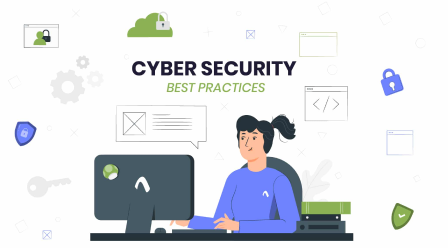The CEH certification training course from Aspire gives you the hands-on experience you need to learn the ways how hackers use to break into network systems and defend your system.This ethical hacking course is compliant with EC-Council's CEH v11 current certification training and it will fully educate you to improve your blue team skills.
-
About this course
Aspire training will teach you certified Ethical Hacker CEH v11 the latest commercial-grade hacking tools, techniques, and methodologies used by hackers and information security professionals to lawfully hack an organization.
-
Why should you take this course?
The CEH is widely regarded as the industry's most advanced certified ethical hacking training in the market. The course covers attack technologies that are routinely utilized by hackers and instructs you on how to respond to these attacks.
By passing this test and earning this certification, you demonstrate that you are capable of identifying weaknesses and vulnerabilities in target systems. It demonstrates that you have the same knowledge and tools as a bad hacker, but you can use them legally and ethically.
-
What will you learn by taking this course?
This course will teach you the hacking skills and technique required to conduct a penetration test on a company.
As you proceed through 12 courses aligned with the seven Certified Ethical Hacker (CEH) exam objectives, you'll study the fundamentals of ethical hacking and penetration testing.After completing the course, you'll be ready to get your CEH certification and have a solid foundation of hacking knowledge that you may use to graduate into more advanced security certifications or new job areas.
-
CHAPTER 1: INTRODUCTION TO ETHICAL HACKING
✅Overview of Current Security Trends
✅Understanding Elements of Information Security
✅Understanding Information Security Threats and Attack Vectors
✅Overview of hacking concepts, types, and phases
✅Understanding ethical hacking concepts and scope
✅Overview of information security management and defense-in-depth
✅Overview of policies, procedures, and awareness
✅Overview of physical security and controls
✅Understanding incidence management process
✅Overview of vulnerability assessment and penetration testing
✅Overview of information security acts and laws
-
CHAPTER 2: FOOTPRINTING AND RECONNAISSANCE
✅ Understanding footprinting concepts
✅ Footprinting through search engines
✅ Footprint using advance google hacking techniques
✅ Footprint through social networking sites
✅ Understanding different techniques for website footprinting
✅ Understanding different techniques for email footprinting
✅ Overview of footprinting Pen Testing
✅Understanding different techniques of competitive intelligence
✅Understanding different techniques for WHO IS footprinting
✅Understanding different techniques for network footprinting
✅Understanding different techniques of footprinting through social engineering
✅Footprinting tools
✅Footprinting countermeasures
-
CHAPTER 3: SCANNING NETWORKS
✅Overview of networking scanning
✅Understanding different techniques to check for Live Systems
✅Understanding different techniques to check for Open Ports
✅Understanding various scanning techniques
✅Understanding various IDS Evasion Techniques
✅Overview of scanning and Pen Testing
✅Understanding banner grabbing
✅Overview of Vulnerability scanning
✅Drawing network diagrams
✅Using Proxies and Anonymizer for attack
✅Understanding IP Spoofing and various detection techniques
-
CHAPTER 4: ENUMERATION
✅Understanding Enumeration Concepts
✅Understanding different techniques for NetBIOS Enumeration
✅Understanding different techniques for SNMP enumeration
✅Understanding different techniques for LDAP enumeration
✅Understanding different techniques for NTP enumeration
✅Understanding different techniques for SMTP and DNS enumeration countermeasures
✅Overview of enumeration pen testing
-
CHAPTER 5: VULNERABILITY ANALYSIS
✅Vulnerability of the management life cycle
✅Understanding various approaches to vulnerability analysis
✅Tools used to perform the vulnerability assessments
✅Vulnerability analysis tools and technique
-
CHAPTER 6: SYSTEM HACKING
✅Overview of CEH Hacking Methodology
✅Understanding different techniques to gain access to the system
✅Understanding privilege escalation techniques
✅Understanding different techniques to create and maintain remote access to the system
✅Overview of different types of Rootkits
✅Overview of Steganograpy and Steganalysis
✅Ungderstanding techniques to hide the evidence of compromise
✅Overview of system hacking penetration testin
-
CHAPTER 7: MALWARE THREATS
✅Introduction to malware and malware propagation techniques
✅Overview of Trojans, their types, and how to infect systems
✅Overview of viruses, their types, and how they infect files
✅Introduction to computer worm
✅Understanding the Malware Analysis Process
✅Understanding different techniques to detect malware
✅Malware countermeasures
✅Overview of Malware penetration testing
-
CHAPTER 8: SNIFFING
✅Overview of sniffing concepts
✅Understanding MAC attacks
✅Understanding DHCP attacks
✅Understanding ARP Poisoning
✅Understanding MAC Spoofing attacks
✅Understanding DNS poisoning
✅Sniffing tools
✅Sniffing countermeasures
✅Understanding various techniques to detect sniffing
✅Overview of sniffing Pen Testing
-
CHAPTER 9: SOCIAL ENGINEERING
✅ Overview of social engineering
✅ Understanding various social engineering techniques
✅ Understanding insider threats
✅ Understanding impersonation on social networking sites
✅ Understanding identity theft
✅ Social engineering countermeasures
✅ Identify theft countermeasures
✅ Overview of Social Engineering Pen Testing
-
CHAPTER 10: DENIAL-OF-SERVICE
✅ Overview of Denial of Service (DoS) and Distributed Denial-of-Service (DDoS) Attacks
✅ Overview different DoS/DDoS) attack techniques
✅ Understanding the botnet network
✅ Understanding various DoS and DDoS Attack Tools
✅ DoS/DDoS Countermeasures
✅ Overview of DoS Attack Penetration Testing
-
CHAPTER 11: SESSION HIJACKING
✅ Understanding session hijacking concepts
✅ Understanding application level session hijacking
✅ Understanding network level session hijacking
✅ Session hijacking tools
✅ Session hijacking countermeasures
✅ Overview of session hijacking penetration testing
-
CHAPTER 12: EVADING IDS, FIREWALLS, AND HONEYPOTS
✅ Understanding IDS, Firewall, and honeypot concepts
✅ IDS, Firewall and honeypot solutions
✅ Understanding different techniques to bypass IDS
✅ Understanding different techniques to bypass firewalls
✅ IDS/Firewall evading tools
✅ Understanding different techniques to detect honeypots
✅ IDS/Firewall evasion countermeasures
✅ Overview of IDS and firewall Penetration Testing
-
CHAPTER 13: HACKING WEB SERVERS
✅ Understanding webserver concepts
✅ Understanding webserver attacks
✅ Understanding webserver attack methodology
✅ Webserver attack tools
✅ Countermeasures against webserver attacks
✅ Overview of Patch Management
✅ Webserver security tools
✅ Overview of Webserver penetration testing
-
CHAPTER 14: HACKING WEB APPLICATIONS
✅ Understanding web application concepts
✅ Understanding web application threats
✅ Understanding web application hacking methodology
✅ Web application hacking tools
✅ Understanding web application countermeasures
✅ Web application security tools
✅ Overview of web application penetration testing
-
CHAPTER 15: SQL INJECTION
✅ Understanding SQL injection concepts
✅ Understanding various types of SQL injection attacks
✅ Understanding SQL injection methodology
✅ SQL injection tools
✅ Understanding different IDS evasion techniques
✅ SQL injection countermeasures
✅ SQL injection detection tools
-
CHAPTER 16: HACKING WIRELESS NETWORKS
✅ Understanding wireless concepts
✅ Understanding wireless encryption algorithms
✅ Understanding wireless threats
✅ Understanding wireless hacking methodology
✅ Wireless hacking tools
✅ Understanding Bluetooth hacking techniques
✅ Understanding wireless hacking countermeasures
✅ Wireless security tools
✅ Overview of wireless penetration testing
-
Chapter 17: HACKING MOBILE PLATFORMS
✅ Understanding mobile attack platform vectors
✅ Understanding various android threat and attacks
✅ Understanding various iOS threats and attacks
✅ Understanding various Windows Phone OS threats and attack
✅ Understanding various blackberry threats and attacks
✅ Understanding mobile device management (MDM)
✅ Mobile Security Guidelines and security tools
✅ Overview of Mobile Penetration Testing
-
CHAPTER 18: IOT HACKING
✅ Understanding IoT concepts
✅ Cryptography tools
✅ Understanding various IoT threats and attacks
✅ Understanding IoT Hacking
✅ Understanding IoT attacks
✅ IoT security Tools
-
CHAPTER 19: CLOUD COMPUTING
✅ Understanding Cloud Computing Concepts
✅ Understanding Cloud Computing Threats
✅ Understanding Cloud Computing Attacks
✅ Understanding Cloud Computing Security
✅ Cloud computing Security tools
✅ Overview of Cloud Penetration testing
-
CHAPTER 20: CRYPTOGRAPHY
✅ Understanding Cryptography concepts
✅ Overview of encryption algorithms
✅ Cryptography tools
✅ Understanding Public Key Infrastructure (PKI)
✅ Understanding email encryption
✅ Understanding disk encryption
✅ Understanding Cryptography attacks
✅ Cryptanalysis Tool
-
Do you need an accredited hacking course to become a hacker?
To master the hacking technologies, you will need to become one, but an ethical one! The accredited hacking course provides the advanced hacking tools and techniques used by hackers and information security professionals alike to break into an organization. As we put it, “To beat a hacker, you need to think like a hacker”.
-
How to become a Certified Ethical Hacker ( CEH )?
Certified Ethical Hacker (CEH) Certification The CEH exam is a 4-hour exam with 125 multiple choice questions. This knowledge based exam will text your skills in Information Security Threats and Attack Vectors, Attack Detection, Attack Prevention, Procedures, Methodologies and more! Access our exam for blueprint for CEH.
-
Which is the best course for Ethical Hacker?
Certified Ethical Hacker Training Course Purdue’s Certified Ethical Hacker (CEH) course is a comprehensive online bootcamp that teaches information security professionals how to find vulnerabilities in information systems and prepares those professionals for the Certified Ethical Hacker certification exam.
- Key Features:
- Created by a Security expert :
- Access period : 12 months
- Course duration : 40+ hours
- Quizzes & revision exams :
- Certificate of completion :
- Support : 24/7 hours

CERTIFIED ETHICAL HACKER
Pick your preferred schedule
Why learn with us?
- We're tech career experts
- 25,000+ students worldwide
- Alternative to traditional university education
- Start a new career or advance your current one & land your dream job
- Award winning StudentCare
- Most in-demand skills for job market
- Partnered with most biggest accreditors in the world
- Exclusive student benefits

Reason to Choose CERTIFIED ETHICAL HACKER

- Exam Pass Guarantee (live online)
- 100% Satisfaction Guarantee
- Immediate access to Aspire portal for practice exam
- Get started with Certification pathway
- Knowledge Transfer Guarantee
- Take advantage of globally recognized platform
Salary Indicator
SALARY PROJECTION
Average
salary after
completing

$180k
You can earn an average of $180,000.00 a year
Find Your Boot Camp
Boost Engagement with delivering Communication Tools

Increase employee engagement with a different suite of communication tools like:
Posters
Promote your training program with visuals you can customize to brand... more
Newsletters
Send training updates and security best practice highlights directly... more
Digital wallpapers and web banners
Increase program engagement with colorful thought-provoking messaging... more
Training Videos/Animations
Strengthen key awareness concepts and skills through stylish visual... more
Why Aspire Tech
Award-winning courses
Aspire's award-winning online courses and programs are created and delivered by a renowned Cyber Security specialist.
The perfect fit for business
Plans for small to large businesses that are flexible to match your budget. There is a volume discount available.
Cost effective training
For a fraction of the expense of traditional classroom training, train thousands of employees in numerous locations.
